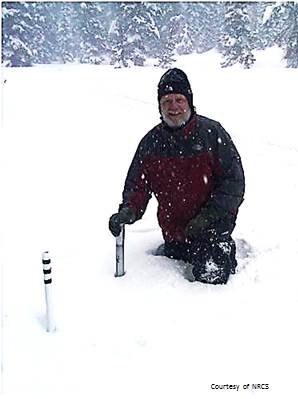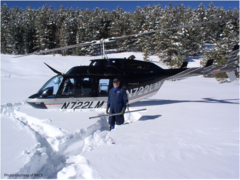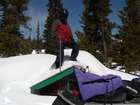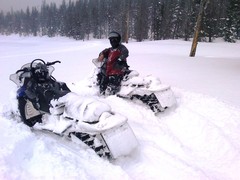
Name Randy Julander
- Education B.S. and M.S. Range and Forest Watershed Management in Hydrologic Fields, Utah State University
- Target Audience Elementary School

Snow - you can ski on it, get a day off of school for it or even be killed by it. For Randy Julander, a Snow Survey Supervisor for the US Department of Agriculture, snow is a dream job. Read more to learn how Julander's interest in the outdoors and extreme weather snowballed into this exciting career!
I am the Snow Survey Supervisor for the Natural Resources Conservation Services (NRCS) and this is one of the most exciting jobs an outdoor, cold loving person like me could have. We measure snow pack, and other high elevation hydroclimatic variables such as precipitation, temperature, soil moisture, soil temperature, snow depth, and all kinds of things in the mountains. We measure these variables both manually going into the mountains by snowmobile, skis or helicopter as well as by telemetry. We have the SNOTEL system that brings us back data every hour on what the snowpack, precipitation, temperature and soils are doing in all the mountains of the west. Then we take that data and run hydrologic models to issue water supply forecasts. Water supply forecasts are phenomenally important in the management of water in the arid west. This information lets us know when we can expect a drought or flood. The agricultural industry uses this type of data to know how much water to expect and how much to plant. This data is used in large variety of ways by many companies and industries - gas rates are even set depending on how much water comes down, dam operations, avalanche forecasting, river operations, barge traffic, recreation and many more uses. And, our forecasts let us know when to expect big fire seasons, like this year.
hydroclimatic variables such as precipitation, temperature, soil moisture, soil temperature, snow depth, and all kinds of things in the mountains. We measure these variables both manually going into the mountains by snowmobile, skis or helicopter as well as by telemetry. We have the SNOTEL system that brings us back data every hour on what the snowpack, precipitation, temperature and soils are doing in all the mountains of the west. Then we take that data and run hydrologic models to issue water supply forecasts. Water supply forecasts are phenomenally important in the management of water in the arid west. This information lets us know when we can expect a drought or flood. The agricultural industry uses this type of data to know how much water to expect and how much to plant. This data is used in large variety of ways by many companies and industries - gas rates are even set depending on how much water comes down, dam operations, avalanche forecasting, river operations, barge traffic, recreation and many more uses. And, our forecasts let us know when to expect big fire seasons, like this year.
Our forecasts are usually very good but there are always times when the weather goes very dry or very wet and then we may not hit the mark. From a statistical sense - we expect about 1 forecast in 20 will fall outside of normal accuracy - or is a bust. Anytime you're in the forecasting business - you're going to make a bad one sometime because the state of climate forecasting isn't robust enough to provide precise and accurate data about the climate several months out for each forecast point. We have a high level of accuracy with our snow and precipitation measurements and other data, but future climate determines some of the forecast outcome. We update stream-flow forecasts on a monthly basis as climate conditions change so we continually provide the best estimate for water supply based on those current conditions.
I grew up as a son of a Forest Ranger and loved working in the woods and outdoors and spending time in snow and water. It's pretty much what I always wanted to do - I'm one of those rare exceptions that knew from very early on what I wanted to do in life. When it came time to choose a career, it was already chosen. I wanted to work in a natural resource environment in the western United States and snow and water was not only fascinating, but seemed to be one of the better career opportunities.

That's one of the great things about this particular job - there are so many different things to do. We are collecting so much information (nearly 22 million individual data observations per year) there is a huge amount of computer work that has to be done as well as data quality control. Then there is a ton of work that has to be done in generating our stream-flow forecasts. We do advanced mathematics/hydrologic modeling on the computer, and when we get tired of that we just go into the next room and work on electronics for our telemetered sites. And, when we get tired of that we can go into the field to do site maintenance at our telemetry sites and learn more about our watersheds - geology, soils, vegetation and such. We spend a lot of time in the summer doing field work. The more you know about a watershed the more in tune you become with the mathematical processes that we use to simulate that watershed. Knowing the geology, soils, vegetation and the history of the watershed allows you to better interpret why a watershed responds the way it does. We also get to manually measure snowpack in the winter time so snowmobiling in some of the most beautiful places on earth comes with the job. You do have to like the cold - some days in the winter it's a very nice 20 below zero and some days it might be an ultra warm 40 degrees.
Everything! I love absolutely everything about my job. I get to spend a ton of time in the mountains and forests doing fun things. In the winter we go out and actually manually measure the snow pack. I hop on my snowmobile and spend 2 or 3 days in the mountains measuring snow and getting to know the watershed in the winter time. Something new we're getting into is aerial reconnaissance to document our sites out in the field. We get to fly a model helicopter with a camera and photo-document every site that we have. Getting a job here is better than being an ice cream tester or an astronaut and the competition to get into this field is getting much tougher because of the new and vibrant things we get to do.
doing fun things. In the winter we go out and actually manually measure the snow pack. I hop on my snowmobile and spend 2 or 3 days in the mountains measuring snow and getting to know the watershed in the winter time. Something new we're getting into is aerial reconnaissance to document our sites out in the field. We get to fly a model helicopter with a camera and photo-document every site that we have. Getting a job here is better than being an ice cream tester or an astronaut and the competition to get into this field is getting much tougher because of the new and vibrant things we get to do.
I grew up in a little tiny town, Alpine, AZ. We had a little 2 room school house with 4 grades on one side and 4 grades on the other side - it was just like little house on the prairie. I absolutely loved science as a kid. In order to be able to do science you have to speak the language and the language of science simply is math. You can't do one without the other. I didn't always love math, but I had some really great teachers who showed me how necessary it was. My advice to kids is if you don't like something, back up and look at it from a different direction and try a different approach. If you want to be a scientist, you have to do the math.
It was always just a part of who I was - there was never a defining moment.
Funding for college was always very difficult. My dad was actually killed in an airplane crash while he was flying reconnaissance on a fire near Flagstaff when I was 16. Without him there, things were tougher, but my mom was phenomenally supportive and convinced me that if I put my mind to it we could make it happen. So, I learned you just make the sacrifices required to accomplish the goals you have in life.
That would be both of my parents - always wonderfully supportive.
The best thing for kids of that age is to use the internet - our NRCS website has a lot of literature and data online. Kids can take this literature and data and actually use it to do fundamental things like measure water and depth in snow pack across the watersheds in their area.
Absolutely! Everything always changes. The US started tracking snow pack in 1906 and the first measurements of snow were done by taking a tube and poking it in the snow. We actually still do this today as a matter of consistency of record. Things have changed a lot since 1906 - we have used a variety of electronic systems and sensors and at the present time we're bringing back hourly data from hundreds of sites. The next great leap will be not only changes in the sensors themselves, but also using satellite applications that would allow us to measure all of these things from space.
(as adapted from NRCS.gov)
Aerial Reconnaissance - the act of scouting or exploring to gain information from the air
Hydrologic Models - water models
Hydroclimatic Variables - changing factors that could include precipitation, temperature, soil moisture, soil temperature, snow depth
NRCS - Natural Resources Conservation Services - a conservation leader for all natural resources, ensuring private lands are conserved, restored, and more resilient to environmental challenges, like climate change
Watershed - an area of land where all of the water that is under it or drains off of it goes into the same place
(as adapted from dictionary.com)
Melissa Di Spigna is a meteorologist at the National Weather Service, a…
Tim Orr's job consists of riding helicopters over volcanoes and collect…